Health and Physical Education
The third-grade health and physical education objectives reflect the Virginia Standards of Learning. Instruction reinforces the Standards of Learning in the core subject areas.
Motor Skill Development
- Performs fundamental motor skills and specialized movement patterns
Anatomical Basis of Movement
- Uses cognitive information to enhance motor skill acquisition and performance
Fitness Planning
- Communicates the knowledge to achieve and maintain a health-enhancing level of fitness
Social Development
- Expresses and uses responsible personal and social behaviors in activity settings
Energy Balance
- Uses health concepts related to health promotion and improvement of personal health
Personal Health
- Demonstrates the ability to access, evaluate and use health information to recognize the relationship between personal behavior and personal health
|
3rd Grade Health and Physical Education |
||||
|
Essential Questions |
How can I combine movements to perform new skills? What does it mean to make healthy choices? What does it look and feel like to test my physical limits? |
|||
|
Unit Title and Quarter |
Quarter 1 |
Quarter 2 |
Quarter 3 |
Quarter 4 |
|
Golden Rule |
Power Up |
Hope Happens |
Future Ready |
|
|
Image Cue |
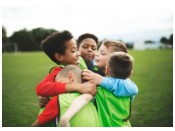 |
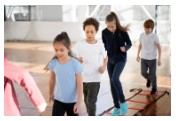 |
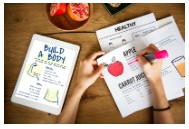 |
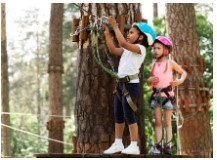 |
|
Focus of the Story |
How we treat others says a lot about us. How we treat our classmates in health and PE determines how we learn and grow together. |
We are faster and stronger than we may know. We can combine our strength and speed to develop agility, refine balance, and show our power. |
It is good to hope and dream, but there has to be some work and a plan. We cannot just hope for good health, we have to set goals and develop plans to make it happen. |
We finish our year by asking ourselves, what do we want to do in the future? What kind of activities and choices will we make to be healthy and fit as we grow up? The answer may surprise you. But you are ready! |
|
Transfer Goals |
Collaborate through activities and games, developing social and competitive skills, improving physical fitness, and increasing ability. Demonstrate socially responsible behavior to include respect for themselves and others, and the environment in thoughts, words, and actions. |
Describe the major parts of the body and how to care for them to improve or maintain personal health. Apply knowledge of bone and muscle movement to articulate movement in a variety of patterns, and spaces for health, enjoyment, or challenge. |
Apply knowledge of bone and muscle movement to articulate movement in a variety of patterns, and spaces for health, enjoyment, or challenge. Analyze diverse sources and perspectives to make thoughtful judgments regarding physical and mental health decisions. Analyze data and use goal-setting skills to identify appropriate choices to enhance well-being. |
Collaborate through activities and games, developing social and competitive skills, improving physical fitness, and increasing ability. Identify internal and external factors that affect community, physical, emotional, and social health and generate possible solutions. |
|
Learning Targets |
I can explain safety rules at home, at school, and in the community. I can explain the difference between conflict and bullying. I can describe refusal skills when pressured to use alcohol, tobacco, inhalants, or other drugs |
I can demonstrate one activity for each component of fitness. I can perform physical activities that use many muscles and bones such as jumping rope, gymnastics, and dance. I can name muscles and bones that are used to perform a chosen exercise. |
I can identify the steps and benefits of goal setting to adopt positive health practices. I can identify, describe and demonstrate levels of exercise intensity. I can define and describe communicable and non-communicable diseases. |
I can develop a plan to get 60 minutes of physical activity every day. I can apply teacher feedback to improve my performance. I can provide appropriate peer feedback to improve performance. |
Instructional Technology
The third-grade Digital Learning Integration Standards offer children a variety of instructional technology experiences based on the Profile of a Virginia Graduate. These standards are comprehensive statements that explain foundational knowledge, skills, and experiences aligned to the grade 3-5 curriculum standards.
Empowered Learner: Students leverage technologies, including assistive technologies, to take an active role in choosing, achieving, and demonstrating competency in their learning goals, informed by the learning sciences.
Digital Citizenship: Students recognize the rights, responsibilities, and opportunities of living, learning and working in an interconnected digital world, and they act in ways that are safe, legal, and ethical.
Knowledge Constructor: Students critically curate a variety of digital resources using appropriate technologies, including assistive technologies, to construct knowledge, produce creative digital works, and make meaningful learning experiences for themselves and others.
Innovative Designer: Students use a variety of technologies, including assistive technologies, within a design process to identify and solve problems by creating new, useful, or imaginative solutions or iterations.
Computational Thinker: Students develop and employ strategies for understanding and solving problems in ways that leverage the power of technological methods, including those that leverage assistive technologies, to develop and test solutions.
Creative Communicator: Students communicate clearly and express themselves creatively for a variety of purposes using appropriate technologies (including assistive technologies), styles, formats, and digital media appropriate to their goals.
Global Collaborator: Students use appropriate technologies, including assistive technologies, to broaden their perspectives and enrich their learning by collaborating with others and working effectively in teams locally and globally.
Essential Information Literacy Skills (EILS)
The third-grade Essential Information Literacy Skills (EILS) enhance student experiences for developing skills in information literacy, inquiry, collaboration, and engaging with knowledge products safely and ethically. These skills are achieved through the collaboration of the classroom teacher and the library media specialist (LMS).
Inquire: Build new knowledge by inquiring, thinking critically, identifying problems, and developing strategies for solving problems.
- Develop and revise questions about topics that interest the student
- Make a plan to find needed information
- Create a product to show learning and act on feedback to improve the product
- Participate in an ongoing inquiry-based process
Include: Demonstrate an understanding of and commitment to inclusiveness and respect for diversity in the learning community.
- Evaluate print and digital information resources for bias and point of view
- Interact with a diverse group of peers in a respectful manner and by sharing their perspectives
- Use digital tools to connect with a variety of learners
Collaborate: Work effectively with others to broaden perspectives and work toward common goals.
- Actively listen in a group and work with others to solve problems
- Use a variety of communication tools and resources
- Breakdown complex problems into smaller steps
Curate: Make Meaning for oneself and others by collecting, organizing, and sharing resources of personal relevance.
- Identify possible sources of information
- Evaluate print and digital resources and make critical choices about information
- Assess the validity and accuracy of information
- Access and evaluate information resources before sharing
- Ethically use and repurpose others’ work
- Use digital tools to collect, analyze and reflect on accuracy resources or relevant data sets
Explore: Discover and innovate in a growth mindset developed through experience and reflection.
- Develop and satisfy personal curiosity by reading widely and deeply in multiple formats and writing for a variety of purposes
- Solve problems through cycles of design and implementation. Persist in self-directed pursuits
- Develop innovative means of investigation and collaboratively identify innovative solutions
- Problem-solve through reflection and revision; be open to feedback.
Engage: Demonstrate safe, legal and ethical creating and sharing of knowledge products independently while engaging in a community of practice and an interconnected world.
- Follow ethical and legal guidelines for gathering and using information by complying with the school division’s Acceptable Use Policy
- Evaluate information for accuracy, validity and appropriateness
- Recognize the importance of citing sources
- Ethically use, cite, and reproduce others’ work to avoid plagiarism
- Keep personal digital identity safe and be aware of the lasting effect of their digital footprint
Art
The elementary art program is designed as a concept-based, sequential curriculum that makes connections between art and life through the disciplines of creative process, critical thinking and communication, history/culture/citizenship, innovation in the arts, art techniques and applications, and the core curriculum.
Emphasis is on developing concepts and skills in inquiry, critical thinking, observation, problem-solving and communication. Students use a balance of learning and creating to examine and to develop an appreciation of the visual images in the world. Elementary art focuses on skills needed for creating art and becoming an informed consumer. Students participate in an art class each week taught by an art teacher.
Creative Process
- Applies the creative process through inquiry, investigation, generating ideas, testing solutions, refining and reflecting on process and product
Critical Thinking and Communication
- Demonstrates an understanding and appreciation that art can have diverse values, meanings and definitions; uses appropriate vocabulary and communication when responding to works of art
History, Culture and Citizenship
- Demonstrates an understanding that art is a reflection of time, place and culture, and identifies the value and reasons for creating art within communities
Innovation in the Arts
- Understands and applies the artistic process, problem-solving skills, current and emerging technologies while making connections to visual arts careers
Technique and Application
- Uses artistic skills and techniques when developing ideas for creative expression through a variety of media
|
3rd Grade Art The visual arts curriculum is taught through the lens of authentic school-based themes and concepts. Units can vary within the needs of each school community. |
||||||
|
Essential Questions |
What Are the Big Issues About Art? How and Why Do We Make Art? How Does Art Relate to History and Culture? How Do We Respond to Works of Art? |
|||||
|
Unit Title and Quarter |
QUARTER 1 |
QUARTER 2 |
QUARTER 3 |
QUARTER 4 |
||
|
Who I Am |
Alone and Together |
Stories and Traditions |
Real World Application |
|||
|
Image Cue |
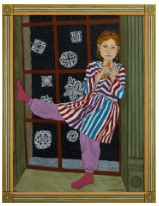
Lee Udall Bennion, Snow Queen: Portrait of Adah, 1992. Oil Painting. |
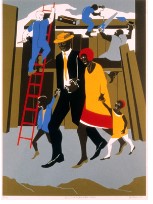
Jacob Lawerence, The Builders, 1974. Silkscreen print. |
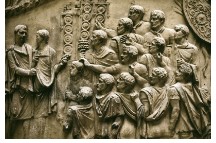
Column of Trajan, (detail): Trajan Addressing His Troops |
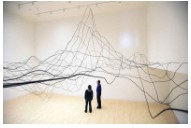
Jaume Plensa, The Crown Fountain, 2004. Digital Technology |
||
|
Focus of the Story |
We begin by starting our journey by looking at how art allows us to “see” our world through the eyes of artists and begin the process of self-reflection through the creative process. We will also identify skills needed to work collaboratively in a creative art community. Developing the art classroom community as a whole. |
Once we understand the beginning steps, we can start to focus on how artists share ideas and learn through the work of others. Art is another way to communicate and make personal connections with the ideas that one shares. |
Now, we can move into discovering and understanding what we learn from the past through art. Artists are inspired by different cultures, traditions, stories, and customs throughout time. They serve as a foundation of what and why we create as artists. |
Finally, we can see how art can help us to develop an understanding of the versatile and unique ways artists express themselves. How artists can apply their knowledge and skills in the real world and make a difference through the arts. |
||
|
Transfer Goals |
The Creative Process Apply creative process through inquiry, investigation, generating ideas, testing solutions, refining, and reflecting on process and product while developing a personalized portfolio exhibiting original voice and vision as an artist. |
Critical Thinking & Communication Understands and develops an appreciation that art can have diverse values, meanings, and definitions while recognizing multiple responses and perspectives. Effective at receiving and articulating ideas using appropriate vocabulary and communication when responding to works of art. Able to work independently and collaboratively. |
History/Culture/Citizenship: Explore and understand historical influences of art through the work of self and others while cultivating an awareness that art is a reflection of time, place and culture. Students identify and interact with art as a community member and citizen, developing a lifelong engagement with art as a supporter, advocate, creator, and informed viewer. |
Technique and Application Uses artistic skills and techniques when developing ideas for creative expression through a variety of media. Innovation in the Arts Understands and applies the artistic process, problem-solving skills, current and emerging technologies while making connections to visual arts careers. |
||
|
Learning Targets |
As an artist, I can: Use the creative process to make art. Use steps of the creative process, including brainstorming, preliminary sketching, planning, and reflecting, to create ideas for and create works of art. |
As an artist, I can: Describe different art careers in the visual arts. Use different skills and techniques when creating art. Use the elements and principles of design in a work of art Use digital media to create a work of art |
As an artist, I can: Explore different cultures and historical influences of art. Explain how history, culture, and the visual arts influence each other. Compare and contrast works of art created by artists of different cultures along with form and function. |
As an artist, I can: Explain a variety of artists and art careers that are in our world. Explore the use of technology for creating and editing works of art. Make connections to themes learned in another content area. |
||
Music
The Virginia Standards of Learning for Grade Three General Music enable students to continue building mastery in the areas of music literacy, including singing, playing instruments, listening, moving, and creating/composing music. Students continue to demonstrate the use of a creative process for creating music. Emphasis is placed on developing skills for singing and instrumental ensemble performance, and the continued development of musical understanding through the study of rhythm, musical form, and melodic notation. Students investigate music from different periods of music history and reflect on ways that music has value to people and communities. Students will begin their study of the recorder. Students participate in a weekly music class taught by a music specialist.
Creative Process
- Improvise and compose music
- Apply a creative process for music
Critical Thinking and Communication
- Analyze music
- Describe how music evokes personal ideas and emotions
- Demonstrate collaboration and communication skills for music rehearsal and performance
History, Culture, and Citizenship
- Explore historical and cultural aspects of music
- Describe roles of music and musicians in communities
- Identify appropriate sources for listening to music
Innovation in the Arts
- Identify how individuals create music
- Identify how music can be created using technology tools
- Identify relationships between music and other fields of knowledge
Technique and Application
- Demonstrate music literacy
- Develop skills for individual and ensemble singing performance
- Develop skills for individual and ensemble instrumental performance
- Classify, perform, and count rhythmic patterns
- Understand and apply the difference between melodic rhythm and steady beat using body percussion, instruments and voice
- Respond to music with movement
|
Course Name |
Grade 3 General Music |
|||
|
Essential Question |
How do I connect, perform, respond, and create music? |
|||
|
Quarter |
Quarter 1 |
Quarter 2 |
Quarter 3 |
Quarter 4 |
|
Unit Title |
Singin’ and Readin’: Reading and Exploring Pitches |
It Takes Two to Make Some Har-Mon-Na-Ay!: Developing Independent Musicianship Skills |
I’ve got Rhythm, I’ve got MUSIC: Learning The Eastman Counting System |
The 21st Century Composer: Learning How to Listen and Create Musical Phrases |
|
Image Cue |
 |
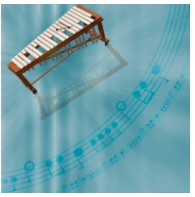 |
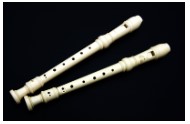 |

|
|
Focus of the Story |
We begin by learning how to read new pitches, expanding the range of our singing voice and exploring music from a variety of times and places. |
Developing musical independence and learning our own musical part and how that fits in with the music others are playing. |
We next move to a new way of counting and performing to grow our music literacy skills using one new instrument: the recorder. |
Our year ends using our music literacy skills to create and share melodies. |
|
Transfer Goals |
Analyze, interpret, and evaluate musical works from a variety of cultures. Use music literacy to demonstrate understanding of the elements of music and the ways they inform artistic performance and creative expression. |
Analyze, interpret, and evaluate musical works from a variety of cultures. Understand and find meaning in music as a form of community engagement through involvement as a performer, supporter, advocate, and audience member. Use music literacy to demonstrate understanding of the elements of music and the ways they inform artistic performance and creative expression. |
Analyze, interpret, and evaluate musical works from a variety of cultures. Understand and apply creative processes to guide the development of ideas, original works, and musical performances. Use music literacy to demonstrate understanding of the elements of music and the ways they inform artistic performance and creative expression. |
Understand and apply creative processes to guide the development of ideas, original works, and musical performance. Analyze, interpret, and evaluate musical works from a variety of cultures. Understand and find meaning in music as a form of community engagement through involvement as a performer, supporter, advocate, and audience member. Use music literacy to demonstrate understanding of the elements of music and the ways they inform artistic performance and creative expression. Use technology as a strategic mechanism for improving music literacy and improving music performance. |
|
Learning Targets |
I can place notes on lines and spaces of the staff, and draw a treble clef. I can read melodies of increasing complexity based on a pentatonic scale. I can sing notated melodies within the range of an octave. I can sing clearly and in tune. I can describe instruments from other time periods and places. |
I can play music in two-part ensembles expressively. I can maintain proper posture for singing. I can sing clearly and in tune. I can sing with expression. I can sing rounds, partner songs, and ostinati in two-part ensembles. I can identify specific names of notes on a treble clef staff. I can use instruments, body percussion, and my voice to perform rhythm patterns. |
I can count and perform rhythm patterns using quarter note/rest, half note/rest, eighth note pair, single eighth note/rest, whole note/rest, and dotted half note. I can identify melodic steps, skips, leaps and repeats on a musical staff. I can use instruments, body percussion, and my voice to perform rhythm patterns. I can play melodies that are notated or given aurally. I can identify specific names of notes on a treble clef staff. I can use appropriate music symbols correctly. |
I can explore plans to create music. I can identify the elements used in creating music using appropriate vocabulary. I can compose melodies using definite pitch and standard notation. I can create music using technology. I can evaluate a musical performance using a specific music standard. I can analyze music in RONDO form. I can use musical terms to describe what I hear when listening to a piece of music. I can read and count rhythms. I can appropriately identify the specific names of notes on a treble clef staff. I can identify melodic steps, skips, leaps and repeats on a musical staff. I can use appropriate musical symbols correctly. |
